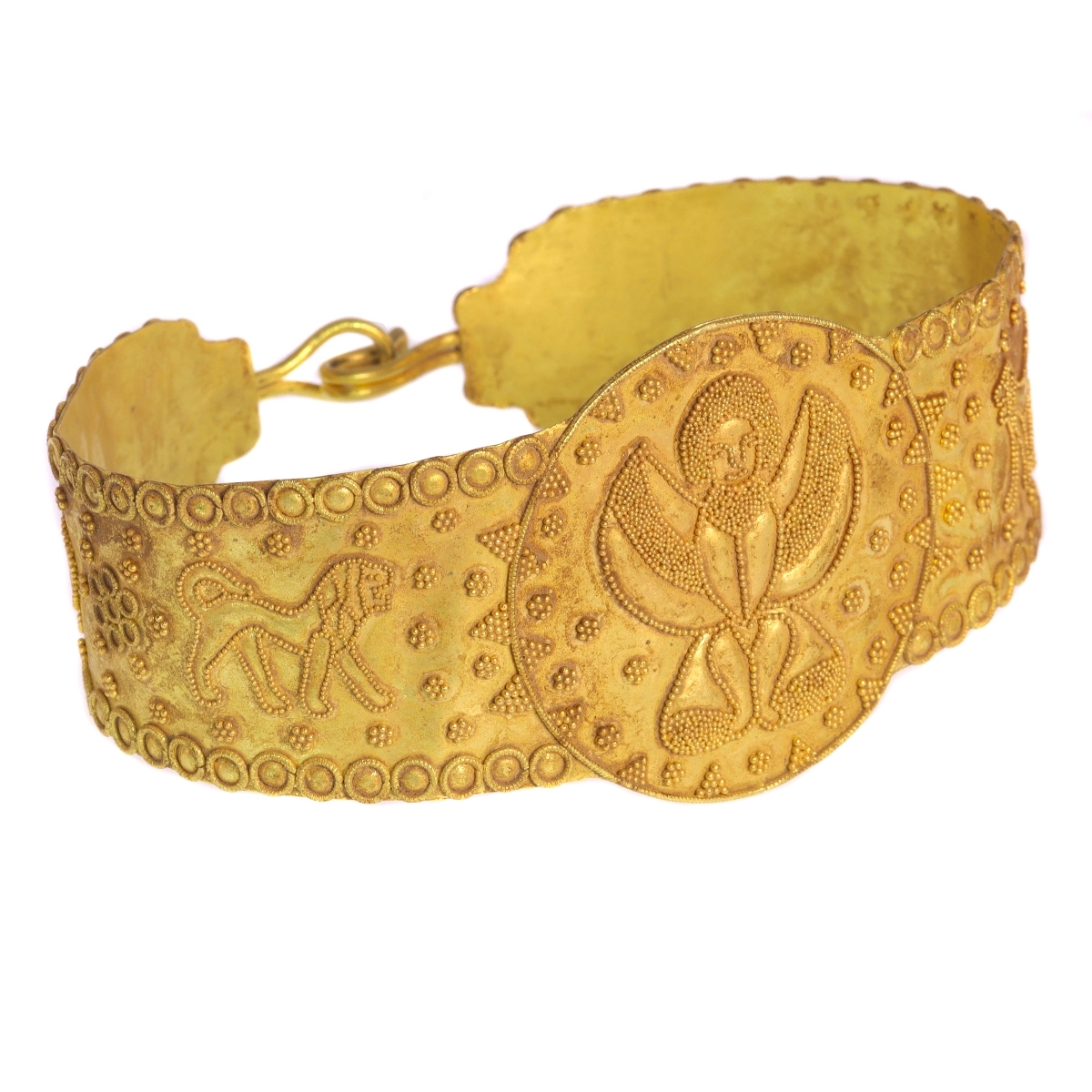We offer layaway, spread payments on the piece of your dreams. Ask us for details. Free insured shipping on all orders !!!
Ancient Assyrian gold granulated bracelet depicting a winged figure accompanied with lions and palmettes as a symbol of protection and prosperity
To offer a genuine ancient artefact like this requires extra research.
Therefore, we've gone through our library, through museum collections and auctions, before we could make any statements
about this unique piece. Now, we're exhilarated to finally share our findings with you.
Description
This bracelet is composed out of a smithed gold top plate and a covering bottom plate with a hook and eye closure. The top of the bracelet is decorated
with small grains of gold -the technique of granulation- and refined twisted gold wires -the technique of filigree.
On the circular center part of the bracelet, the gold granules depict a four-winged (seemingly fore- and hindwings) figure with a human face and head piece. On each side part of the bracelet, we can clearly distinguish a lion's contour from gold spheres.
Subsequently even more outwards from the center, a small field of flowers shaped by filigree and granules guides us to the larger granulated flower bud or palm-like plant seemingly in a flowerpot from filigree circles on each of the bottom parts of the
piece.
The edges of the side parts of the bracelet are marked by an alignment of small hammered domes encircled by filigree.
Dating and symbolism
Resemblance with Assyrian art (2000 BCE - 612 BCE):
A winged figure with a human face occurs in many cultures and has evolved through many eras. However, the combination with lions, with such flower buds and the ancient techniques of granulation and filigree guides us to the Assyrian period from 2000 BCE
until 612 BCE in the Mesopotamian region (alluvial plains of the Tigris and Euphrates), modern state of Iraq.
During this period, we see many artifacts (mostly in bas-reliefs in architecture and tiles) depicting a male figure,
wearing a helmet and with wings -sometimes only two upward wings, and sometimes also with two downward wings, and
sometimes even with the body of a bee.
Furthermore, this winged figure is often accompanied by lions or shown to have fought down a lion. The lion is assumed to be the king of all animals in many cultures, but specifically in Assyrian culture men are often illustrated while fighting lions.
The winged figure clearly stands above the lion.
Besides that, the winged figure is also often depicted with certain plants, sometimes referring to a poppy stem (plant of relief), sometimes to a date palm (the tree of life), and sometimes to a pine cone (symbol of masculinity). The figures with the
tree of life, with a date palm or with the pine cone also often carry a bag with pollen to fertilise the tree of life or a bucket with water (symbol of femininity) to dip the pine cone and sprinkle water on the tree of life.
In art history, this winged figure often accompanied by lions and/or these plants is referred to as a "winged spirit" or "winged genie" or "the spirit of the bees". These spirits are a symbol of protection -as ruler of the king of animals, the lion- and
a symbol of prosperity -referring to the tree of life and to the fertilisation with pollen as bees do.
Besides this spirit, art history shows another figure from the Assyrian culture often depicted in such manner, namely the god Ninurta, who is associated with farming, healing and hunting. The link between those three characteristics and his attributes
are obvious as well.
We can't say with certainty what this bracelet is referring to or from which century it exactly is, but according to us all signs of craftsmanship and iconography point to the Assyrian art period. More specifically, most reliefs from the winged spirit
date from around 800 BCE.
Based on these sources, we offer the following general information about this bracelet. Of course, we're very much open for any information from experts in this field.
Antique jewelry object group
Bracelet
Condition
Very good condition, especially considering that we can safely state that this piece dates from
More info on our condition scale
Country of origin
Ancient Assyrian Empire, which stretched from Mesopotamia (modern-day Iraq) through Asia Minor (modern-day Turkey) and down through Egypt.
Style
Ancient Assyrian
Period
ca.800 BCE
Function
Based on the reference to the Assyrian winged spirit and the god Ninurta, this bracelet could have served as a charm for protection and prosperity.
Material
Not tested, but a high alloy of gold (18K+).
Technique
Granulation is a technique with which the goldsmith uses very small balls (granules) of metal, that are not soldered onto the jewel but welded. This technique demands very high skills and precision from the maker.
Filigree is a delicate kind of jewellery work with twisted wires, usually of gold or silver. These spiraled wires are often being soldered together to form an ornament or object.
Dimensions
Outercircumference of bracelet (when closed): ca. 22,00 cm (8,66 inches).
Diameter of circular top: ca. 4,00 cm (1,57 inches).
Widest part of tapered bracelet band: ca. 3,00 cm (1,18 inch).
Thickness of bracelet band: ca. 1,64 cm (0,06 inch).
See picture with a ruler in cm and inches
Weight
44,40 gram (28,55 dwt)
Adin Reference Nº
16202-0037
Copyright photography
Adin, fine antique jewellery
Sources
Seton, H.F.L., (2019, October 30 last revised), Mesopotamian art and architecture: The art and architecture of the ancient Mesopotamian civilizations. Consulted on May 26, 2021, on
https://www.britannica.com/art/Mesopotamian-art/
Mark, J.J., (2017, February 2), Ninurta. Consulted on May 26, 2021, on
https://www.worldhistory.org/Ninurta/
Mark, J.J., (2014, June 30), Neo-Assyrian Empire. Consulted on May 26, 2021, on
https://www.worldhistory.org/Neo-Assyrian_Empire/
Additional information
our latest acquisitions
jewelry glossary
wall of fame
visit us in Antwerp
subscribe to our mailinglist




